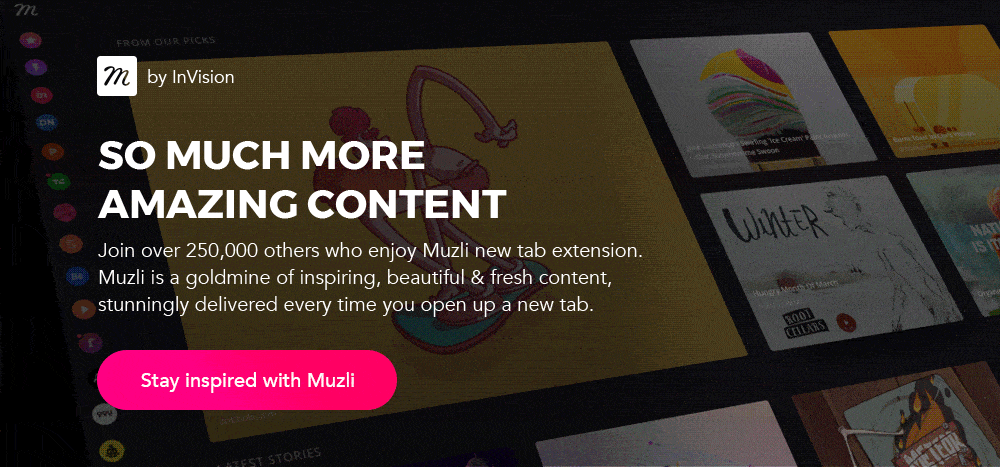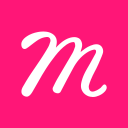Abstract design trend 2018
Tips and tricks for reproducing the style with finesse.
By now, you might think that everything has been done before and there is no room for innovation in Digital Design. But this couldn’t be further from the truth. New ideas or creative recycling/refurbishing of older ideas keep popping up as brands try to attract attention and designers to impress. Useful and valuable ideas stick around and eventually become design trends.
Useful and valuable ideas stick around and eventually become design trends.
Lately, we’ve seen brands and designers experimenting with a combination of organic and geometric design elements, focusing more on the general look and feel rather than the accurate description of a concept. It seems like the return of abstract design!
Geometric shapes such as circles, rectangles and polygons, have been present in Digital Design for a while and they have been very successful so far. They help with organising content by creating structure and clarity. In Illustration, they add an element of simplicity, allowing our imagination to add layers of detail and the message to shine.
The clean geometric style has now evolved with the addition of organic, natural and free-form shapes. Wavy lines, dynamic curves, and powerful arches stand in contrast to the geometric, more functional style, creating unique, engaging and attention-grabbing compositions. The result is often abstract, symbolic and less descriptive, leaving plenty of room for discover-ability and interpretation. This can be both a good and a bad thing, depending on the context. The designer comes to decide if the style is suitable for the given situation.
This abstract, organic and geometric style inclination can influence and shape 2018’s design direction. Familiarising with the hidden meanings and perceptual impact of shapes is now more significant than ever.
Geometric shapes
Geometric shapes are balanced and easily recognisable. They usually suggest structure, order and efficiency.

Squares and rectangles are the most popular. They create a sense of equality and order. They are perceived to be stable and trusting.

Circles and ovals are the most friendly. They represent unity, wholeness, and infinity. They are perceived to be protective, harmonious and graceful.

Triangles are the most controversial. They are tense, bold and actionable. They can be unstable, creating feelings of nervousness, conflict and aggression or stable representing the law, science and religion.

Spirals are the most creative. They suggest growth and evolution. They convey ideas of transformation, life and mysticism. Clockwise spirals can imply intent while counterclockwise spirals imply fulfillment.

Crosses are the most spiritual. They symbolise balance, healing, wisdom, hope and faith. Vertically-oriented crosses are thought of strong, while horizontal peaceful.
Organic shapes
Organic shapes are irregular, free-flowing and less symmetrical. They usually represent or resemble elements found in nature. Organic shapes tend to get their meaning from the natural elements they represent or resemble.

Spiky shapes are the most rebellious. They are spontaneous, playful, unpredictable and attention-grabbing.

Cloudy shapes are the most pleasant. They are friendly, warm, comforting and kind.

Wavy shapes are the most chilled. They are relaxing, smooth and sometimes unpredictable which makes them compelling.
Abstract shapes
Abstract shapes are simplified versions of common elements or forms. They are mostly based on organic and geometric shapes although lacking definition.
Abstract shapes are usually arbitrary since they can take many different forms. They can communicate various ideas or emotions a depending on their basic form and details. Abstract shapes can get exceptionally interesting and unique. They can be edgy, playful, mysterious, relaxing or even purposely confusing. They can be anything we want!
Now that we know a bit more about the basic elements of the abstract style we can work towards refining our designs, making more out of our compositions. We can add some depth, personality and interest by using colours, gradients, textures, patterns, typography and photography.
Colour
Colour has the ability to communicate, influence or support emotions, messages and ideas. It’s bound to our perception of the world as we evolved.

White the safe — Innocent, pure and clean
Black the mysterious — Formal, enigmatic and sophisticated
Red the energetic — Dangerous, powerful and passionate
Orange the warming — Creative, enthusiastic and encouraging
Yellow the optimistic — Energetic, loyal and joyful
Green the harmonious — Fresh, natural and safe
Blue the trustworthy — Confident, intelligent and wise
Purple the noble — Luxurious, wise and ambitious
Pink the charming — Sweet, tender and playful
In visual perception a color is almost never seen as it really is — as it physically is. This fact makes color the most relative medium in art.
Josef Albers
Of course, colours are more complicated than that and different shades, tints and colour combinations, could have different perceptual effects. They could also convey different emotions or meanings for different people. Age, race, culture, gender, impaired vision and even mood can influence their perception. That’s why we shouldn’t rely solely on colour for communicating a message or action. We should take a step back to consider our goals and audience first.
Gradients

A gradient is a graduated blend of two or more colours or tints of the same colour. Gradients are everywhere in nature that’s why they feel pleasant and familiar. They can bring depth and dimension to compositions producing something that looks fresh, unique and modern.
We can get viewers attention by using bright colour combinations or we can create depth and definition by using a darker palette. Using colours that are closer to each other, on the colour wheel, will create a smoother and brighter transition while using colours that are further away will generate a more neutral middle colour, which isn’t always appealing. We can solve this problem by adding a third brighter colour between these colours.
We can get creative by adjusting the opacity, changing the rotation or messing the gradient for some unique results. We can definitely get inspired by nature for creating some pretty smooth gradients.
Patterns

Patterns are the repetition of more than one visual elements. They bring unity, texture and detail within the artwork and can enhance visual excitement by enriching surface interest. Patterns can also add visual noise, so simplicity and subtlety are keys.
Patterns add a sense of rhythm and movement in our abstract composition. There are five types of visual rhythm, random, regular, alternating, flowing and progressive. Each can offer endless combinations and possibilities. We can use patterns either inside simple shapes or in the background.
Textures

Textures refer to the surface quality and are great for adding an extra level of interest, visual complexity and depth in our abstract design. They can be used to illustrate not only how a surface looks but also how it feels and they can be quite powerful in communicating sensations. A texture can be rough, rough, smooth, soft, silky, shiny, fuzzy, liquid and so on. It can be natural or artificial/synthetic, thick or thin, solid or fluid.
Typography

Typography is the art and technique of choosing and arranging typefaces.
When it comes to choosing a typeface, we will first have to identify the purpose and audience of our design. What is the message we want to convey? What kind of emotions do we want to communicate? Who do we want to attract, challenge, convince, inform etc.?
Typography is key to setting mood, tone and style in our design. Each typeface has its own personality. It can be friendly, fancy, serious, aggressive, playful and so on. Its personality can influence how we feel about the copy we’re reading, but also how well we can absorb and process the information within.
There are times where we need to break out of our comfort zone and explore, using different typefaces to create a visual contrast. We can achieve this by using different styles of fonts, font sizes, weights, and colours. We need to be careful though because it’s easy to go too far, using way too many different typefaces can result in a confusing and not as professional design.
Photography

With the use of photography, we can add even more depth, emotion and character to our design. Choosing the right photo can make a big difference, and it has to be in line with the theme and style of our design to create better impact.
There are many different types of photography depending on the theme, technique and style. There’s landscape photography, portrait, still life, black and white, fashion, beauty, nature, aerial, street, conceptual and so on. And to add to all these different types, we can manipulate these photos, making them unrecognisable. We can make them lighter, brighter, darker, we can change their colours, crop them, trace them, blurry them, distort them etc. The possibilities here are truly endless.
We can also get creative with how we apply photography. We can use it as a background or we can mask it, we can use it whole or just parts of it, we can also zoom in and use it as a texture. We can write on it, colour it, trace it, break it, tear it, frame it and so on.
Visual hierarchy, contrast & balance
So, how do we combine all these different visual elements without ending up with a beautiful mess? Hierarchy, contrast and balance will help us create attention-grabbing and easy to read compositions. Here are some design principles to help us tame our design.

Size — Enlarging an object’s size is an easy and quite effective way of adding some visual importance. Using different scales of elements will naturally guide the eye to the most prominent.
Colour — We are naturally attracted to colour. Bright colours are hard to miss, but in a canvas full of colour nothing will stand out. Using attention-grabbing colours sparingly and purposefully is the key. We can play with different colour temperatures, shades, tints and saturation. We can use bright or muted colours strategically, creating high and low contrast areas in our design.
White space — Spacing is a powerful design tool for guiding the viewer’s eye around the design, separating the different visual elements and creating visual hierarchy. White space can give the eyes a place to rest, travel smoothly and identify focal points.
Movement — Our eyes are drawn naturally to points of interest and movement is one of them. Movement indication will help point towards specific elements and make them stand out.
Symmetry & Asymmetry — Visual balance that derives from symmetry can bring harmony and order. Disturbing this balance with some asymmetrical elements will add interest and intensity.
*Some other useful tools to consider are the Golden Ration for balanced, natural looking compositions. Gestalt principles for visual grouping and Alignment for structure. The Visual Triangle for some emphasis or the Rule of Thirds for creating a strong composition.
Use with caution

Hopefully, you now have a better understanding of the different elements that can work together to achieve the abstract design style and a useful set of tools at your disposal.
At this point, you have to keep in mind that everyone is different and arbitrary compositions could get arbitrary readings depending on the viewer. Use this style with caution, avoiding it when your message isn’t clear enough or its understanding is heavily relying on the visual elements.
Conclusion
Many contemporary brands are already embracing the abstract style, take a look at Geex Arts, Intercom and Upperquad. The careful application of this trend offers endless possibilities for communicating different moods and shifting the look & feel of entire projects. Knowing more about the communicative properties of the available design elements can help us reproduce the style; use it effectively and wisely.
A new world of exciting design opportunities lies ahead!



